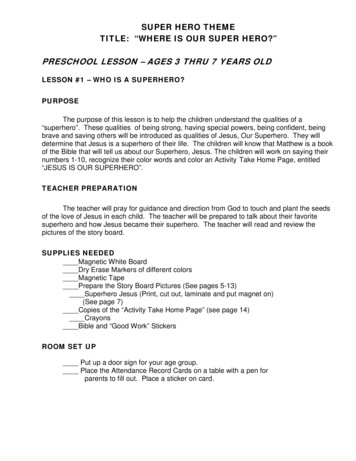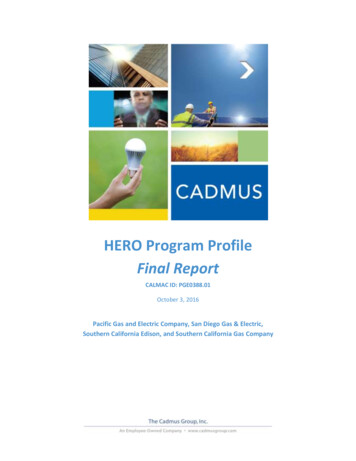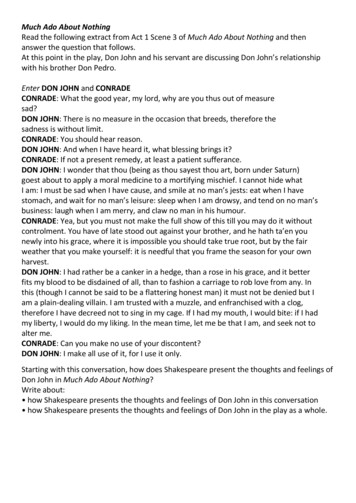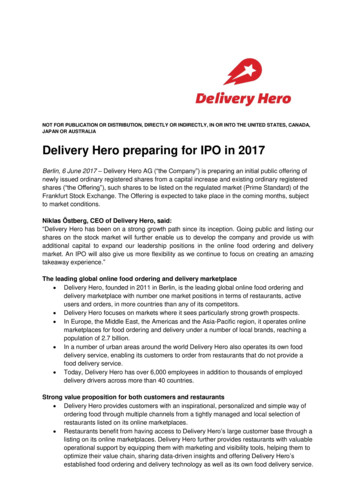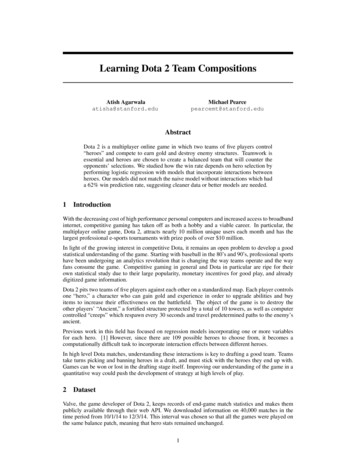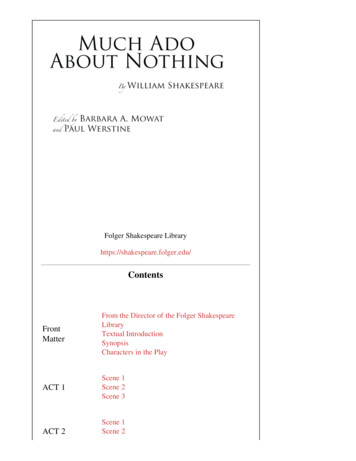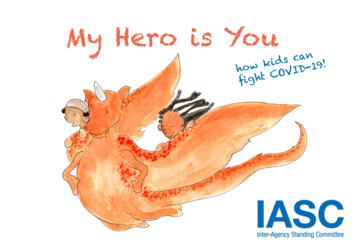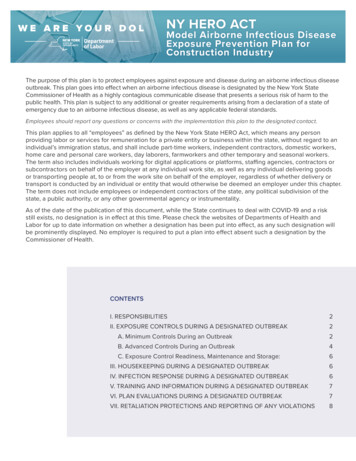
Transcription
NY HERO ACTModel Airborne Infectious DiseaseExposure Prevention Plan forConstruction IndustryThe purpose of this plan is to protect employees against exposure and disease during an airborne infectious diseaseoutbreak. This plan goes into effect when an airborne infectious disease is designated by the New York StateCommissioner of Health as a highly contagious communicable disease that presents a serious risk of harm to thepublic health. This plan is subject to any additional or greater requirements arising from a declaration of a state ofemergency due to an airborne infectious disease, as well as any applicable federal standards.Employees should report any questions or concerns with the implementation this plan to the designated contact.This plan applies to all “employees” as defined by the New York State HERO Act, which means any personproviding labor or services for remuneration for a private entity or business within the state, without regard to anindividual’s immigration status, and shall include part-time workers, independent contractors, domestic workers,home care and personal care workers, day laborers, farmworkers and other temporary and seasonal workers.The term also includes individuals working for digital applications or platforms, staffing agencies, contractors orsubcontractors on behalf of the employer at any individual work site, as well as any individual delivering goodsor transporting people at, to or from the work site on behalf of the employer, regardless of whether delivery ortransport is conducted by an individual or entity that would otherwise be deemed an employer under this chapter.The term does not include employees or independent contractors of the state, any political subdivision of thestate, a public authority, or any other governmental agency or instrumentality.As of the date of the publication of this document, while the State continues to deal with COVID-19 and a riskstill exists, no designation is in effect at this time. Please check the websites of Departments of Health andLabor for up to date information on whether a designation has been put into effect, as any such designation willbe prominently displayed. No employer is required to put a plan into effect absent such a designation by theCommissioner of Health.CONTENTSI. RESPONSIBILITIES2II. EXPOSURE CONTROLS DURING A DESIGNATED OUTBREAK2A. Minimum Controls During an Outbreak2B. Advanced Controls During an Outbreak4C. Exposure Control Readiness, Maintenance and Storage:6III. HOUSEKEEPING DURING A DESIGNATED OUTBREAK6IV. INFECTION RESPONSE DURING A DESIGNATED OUTBREAK6V. TRAINING AND INFORMATION DURING A DESIGNATED OUTBREAK7VI. PLAN EVALUATIONS DURING A DESIGNATED OUTBREAK7VII. RETALIATION PROTECTIONS AND REPORTING OF ANY VIOLATIONS8
I. RESPONSIBILITIESThis plan applies to all employees of , and [all]/[the following work sites]:This plan requires commitment to ensure compliance with all plan elements aimed at preventing the spread ofinfectious disease. The following supervisory employee(s) are designated to enforce compliance with the plan.Additionally, these supervisory employees will act as the designated contacts unless otherwise noted in this plan:NameTitleLocationPhoneII. EXPOSURE CONTROLS DURING A DESIGNATED OUTBREAKA. MINIMUM CONTROLS DURING AN OUTBREAKDuring an airborne infectious disease outbreak, the following minimum controls will be used in all areas of theworksite:1. General Awareness: Individuals may not be aware that they have the infectious disease and can spread it toothers. Employees should remember to: Maintain physical distancing; Exercise coughing/sneezing etiquette; Wear face coverings, gloves, and personal protective equipment (PPE), as appropriate; Individuals limit what they touch; Stop social etiquette behaviors such as hugging and hand shaking, and Wash hands properly and often.2. “Stay at Home Policy”: If an employee develops symptoms of the infectious disease, the employee shouldnot be in the workplace. The employee should inform the designated contact and follow New York StateDepartment of Health (NYSDOH)and Centers for Disease Control and Prevention (CDC) guidance regardingobtaining medical care and isolating.3. Health Screening: Employees will be screened for symptoms of the infectious disease at the beginning of theirshift. Employees are to self-monitor throughout their shift and report any new or emerging signs or symptomsof the infectious disease to the designated contact. An employee showing signs or symptoms of the infectiousdisease should be removed from the workplace and should contact a healthcare professional for instructions.The health screening elements will follow guidance from NYSDOH and CDC guidance, if available.2
4. Face Coverings: To protect your coworkers, employees will wear face coverings throughout the workday to thegreatest extent possible. Face coverings and physical distancing should be used together whenever possible.The face covering must cover the nose and mouth, and fit snugly, but comfortably, against the face. Theface covering itself must not create a hazard, e.g. have features could get caught in machinery or causesevere fogging of eyewear. The face coverings must be kept clean and sanitary and changed when soiled,contaminated, or damaged.5. Physical Distancing: Physical distancing will be followed as much as feasible. Avoid unnecessary gatheringsand maintain a distance of at least six feet (or as recommended by the NYSDOH/CDC for the infectious agent)from each other. Use a face covering when physical distance cannot be maintained.In situations where prolonged close contact with other individuals is likely, use the following control methods: (Note toemployer: Check off the controls you intend to use and add any additional controls not listed here.) restricting or limiting customer or visitor entry; limiting occupancy; allowing only one person at a time inside small enclosed spaces with poor ventilation; reconfiguring workspaces; physical barriers; signage; floor markings; telecommuting; remote meetings; preventing gatherings; restricting travel; creating new work shifts and/or staggering work hours; adjusting break times and lunch periods; delivering services remotely or through curb-side pickup; 6. Hand Hygiene: To prevent the spread of infection, employees should wash hands with soap and water for atleast 20 seconds or use a hand sanitizer with at least 60% alcohol to clean hands BEFORE and AFTER: Touching your eyes, nose, or mouth; Touching your mask; Entering and leaving a public place; and Touching an item or surface that may be frequently touched by other people, such as door handles, tables, gaspumps, shopping carts, or electronic cashier registers/screens.Because hand sanitizers are less effective on soiled hands, wash hands rather than using hand sanitizer whenyour hands are soiled.7. Cleaning and Disinfection: See Section V of this plan.8. “Respiratory Etiquette”: Because infectious diseases can be spread by droplets expelled from the mouthand nose, employees should exercise appropriate respiratory etiquette by covering nose and mouth whensneezing, coughing or yawning.9. Special Accommodations for Individuals with Added Risk Factors: Some employees, due to age, underlyinghealth condition, or other factors, may be at increased risk of severe illness if infected. Please inform yoursupervisor or the HR department if you fall within this group and need an accommodation.3
B. ADVANCED CONTROLS DURING AN OUTBREAKFor activities where the Minimum Controls alone will not provide sufficient protection for employees, additionalcontrols from the following hierarchy may be necessary. Employers should determine if the following arenecessary:1. Elimination: Employers should consider the temporary suspension or elimination of risky activities whereadequate controls could not provide sufficient protection for employees.2. Engineering Controls: Employers should consider appropriate controls to contain and/or remove the infectiousagent, prevent the agent from being spread, or isolate the worker from the infectious agent. Examples ofengineering controls include: Opening outside windows and doors; Opening windows on one side of the room to let fresh air in and installing window exhaust fans on the oppositeside of the room so that they exhaust air outdoors; Automatic disinfection systems such as ultraviolet light disinfection systems; Install additional timeclocks to avoid overcrowding. Consider touch free options; Air purifiers; Install hand washing or sanitizing stations throughout the worksite; and Utilize doors, walls, or plastic sheeting as physical barriers to separate workers;Subject to changes based on operations and circumstances surrounding the infectious disease, engineeringcontrols that are anticipated to be used are listed in the following table:Engineering Controls Utilized/Location:Note to Employer: One of the best ways to reduce exposure to infectious agents is to improve ventilation. The aim is to delivermore “clean air” into an occupied area and exhaust the contaminated air to a safe location. In some cases, the air may have tobe filtered before it enters the work area and/or before it is exhausted. Direct the contaminated air away from other individualsand from the building’s fresh air intake ports. Consult your ventilation system’s manufacturer or service company to determine ifimprovements are possible for your system.3. “Administrative Controls” are policies and work rules used to prevent exposure. Examples include: Increasing the space between workers; Prohibit eating and drinking in the work area; Do not allow sharing of tools; Cancelling any recreational activity on site; Disinfecting procedures for specific operations; Employee training; Identify and prioritize job functions that are essential for continuous operations; Cross-train employees to ensure critical operations can continue during worker absence;4
Post signs reminding employees of respiratory etiquette, masks, hand hygiene; Rearrange traffic flow to allow for one way walking paths; Provide clearly designated entrance and exits; Provide additional short breaks for handwashing and cleaning; Prohibit using compressed air or dry sweeping for cleaning; Clean equipment and tools prior to handoff; Limit attendance to in-person meetings (including toolbox talks, pre-shift meeting, safety meetings). Host themeetings outdoors; Ensure portable toilets are kept clean.Subject to changes based on operations and circumstances surrounding the infectious disease, the followingspecific administrative controls are anticipated to be used:Administrative Controls Utilized/Location:4. Personal Protective Equipment (PPE): Devices like eye protection, face shields, respirators, and glovesthat protect the wearer from infection. PPE will be provided, used and maintained in a sanitary and reliablecondition at no cost to the employee. The PPE provided to an employee will be based on a hazard assessmentfor the workplace. The following PPE that are anticipated to be used are in the following table:PPE Required - Activity Involved/Location:1 The use of respiratory protection, e.g. an N95 filtering facepiece respirator, requires compliance with the OSHA RespiratoryProtection Standard 29 CFR 1910.134 or temporary respiratory protection requirements OSHA allows for during the infectiousdisease outbreak.2 Respirators with exhalation valves will release exhaled droplets from the respirators. Respirators are designed to protect thewearer. Surgical masks and face coverings, which are not respirators, are designed to protect others, not the wearer.5
C. EXPOSURE CONTROL READINESS, MAINTENANCE AND STORAGE:The controls we have selected will be obtained, properly stored, and maintained so that they are ready forimmediate use in the event of an infectious disease outbreak and any applicable expiration dates will be properlyconsidered.III. HOUSEKEEPING DURING A DESIGNATED OUTBREAKA. Disinfection Methods and SchedulesObjects that are touched repeatedly by multiple individuals, such as door handles, light switches, controlbuttons/levers, dials, levers, water faucet handles, computers, phones, or handrails must be cleaned frequentlywith an appropriate disinfectant. Surfaces that are handled less often, or by fewer individuals, may require lessfrequent disinfection.The disinfection methods and schedules selected are based on specific workplace conditions.The New York State Department of Environmental Conservation (NYSDEC)and the Environmental ProtectionAgency (EPA) have compiled lists of approved disinfectants that are effective against many infectiousagents (see dec.ny.gov and ered-disinfectants). Selectdisinfectants based on NYSDOH and CDC guidance and follow manufacturer guidance for methods, dilution,use, and contact time.B. Adjustments to Normal Housekeeping ProceduresNormal housekeeping duties and schedules should continue to be followed during an infectious diseaseoutbreak, to the extent practicable and appropriate consistent with NYSDOH and/or CDC guidance in effect atthe time. However, routine procedures may need to be adjusted and additional cleaning and disinfecting maybe required.Housekeeping staff may be at increased risk because they may be cleaning many potentially contaminatedsurfaces. Some housekeeping activities, like dry sweeping, vacuuming, and dusting, can resuspend into theair particles that are contaminated with the infectious agent. For that reason, alternative methods and/orincreased levels of protection may be needed.Rather than dusting, for example, the CDC recommends cleaning surfaces with soap and water beforedisinfecting them. Conducting housekeeping during “off” hours may also reduce other workers’ exposures tothe infectious agent. Best practice dictates that housekeepers should wear respiratory protection. See cdc.govfor more guidance.C. If an employee develops symptoms of the infectious disease at work, it is ideal to isolate the area inaccordance with guidance issued by NYSDOH or the CDC, before cleaning and disinfecting the sickemployee’s work area. This delay will allow contaminated droplets to settle out of the air and the space to beventilated.D. As feasible, liners should be used in trash containers. Empty the containers often enough to prevent overfilling.Do not forcefully squeeze the air out of the trash bags before tying them closed. Trash containers may containsoiled tissue or face coverings.IV. INFECTION RESPONSE DURING A DESIGNATED OUTBREAKIf an actual, or suspected, infectious disease case occurs at work, take the following actions: Instruct the sick individual to wear a face covering and leave the worksite and follow NYSDOH/CDC guidance. Follow local and state authority guidance to inform impacted individuals.6
V. TRAINING AND INFORMATION DURING A DESIGNATED OUTBREAKA. will verbally inform all employees of the existence and locationof this Plan, the circumstances it can be activated, the infectious disease standard, employer policies, andemployee rights under the HERO Act. (Note: training need not be provided to the following individuals: anyindividuals working for staffing agencies, contractors or subcontractors on behalf of the employer at anyindividual work site, as well as any individual delivering goods or transporting people at, to or from the worksite on behalf of the employer, where delivery or transport is conducted by an individual or entity that wouldotherwise be deemed an employer under this chapter)B. When this plan is activated, all personnel will receive training which will cover all elements of this plan and thefollowing topics:1. The infectious agent and the disease(s) it can cause;2. The signs and symptoms of the disease;3. How the disease can be spread;4. An explanation of this Exposure Prevention Plan;5. The activities and locations at our worksite that may involve exposure to the infectious agent;6. The use and limitations of exposure controls7. A review of the standard, including employee rights provided under Labor Law, Section 218-B.C. The training will be1. Provided at no cost to employees and take place during working hours. If training during normal workhours is not possible, employees will be compensated for the training time (with pay or time off);2. Appropriate in content and vocabulary to your educational level, literacy, and preferred language; and3. Verbally provided in person or through telephonic, electronic, or other means.VI. PLAN EVALUATIONS DURING A DESIGNATED OUTBREAKThe employer will review and revise the plan periodically, upon activation of the plan, and as often as needed tokeep up-to-date with current requirements. Document the plan revisions below:Plan Revision HistoryDateParticipantsMajor Changes7Approved By
Plan Revision HistoryDateParticipantsMajor ChangesApproved ByVII. RETALIATION PROTECTIONS AND REPORTING OF ANY VIOLATIONSNo employer, or his or her agent, or person, , acting as or on behalf of a hiring entity, or the officer or agentof any entity, business, corporation, partnership, or limited liability company, shall discriminate, threaten,retaliate against, or take adverse action against any employee for exercising their rights under this plan,including reporting conduct the employee reasonably believes in good faith violates the plan or airborneinfectious disease concerns to their employer, government agencies or officials or for refusing to work wherean employee reasonably believes in good faith that such work exposes him or her, other workers, or the publicto an unreasonable risk of exposure, provided the employee, another employee, or representative has notifiedthe employer verbally or in writing, including electronic communication, of the inconsistent working conditionsand the employer’s failure to cure or if the employer knew or should have known of the consistent workingconditions.Notification of a violation by an employee may be made verbally or in writing, and without limitation to formatincluding electronic communications. To the extent that communications between the employer and employeeregarding a potential risk of exposure are in writing, they shall be maintained by the employer for two years afterthe conclusion of the designation of a high risk disease from the Commissioner of Health, or two years after theconclusion of the Governor’s emergency declaration of a high risk disease. Employer should include contactinformation to report violations of this plan and retaliation during regular business hours and for weekends/othernon-regular business hours when employees may be working.8
P765b (7/21)
c. exposure control readiness, maintenance and storage: 6 iii. housekeeping during a designated outbreak 6 iv. infection response during a designated outbreak 6 v. training and information during a designated outbreak 7 vi. plan evaluations during a designated outbreak 7 vii. retaliation protections and reporting of any violations 8

